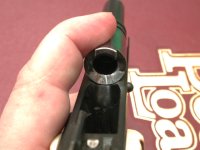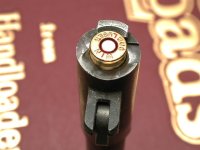I received my reduced mainsprings yesterday from Wolff - 20, 21 and 21#. I shoulda checked the mail earlier because I had just finished putting the gun together for a little "it looks like a real gun" time. I still haven't gotten the bushing turned and locked yet, I'm waiting on the bushing wrench I had to order. I couldn't find the one I thought we had around here 
I did tootle around with the sear and hammer yesterday. I pulled out my flat stone and touched up the hooks on the hammer. I also smoothed them down a bit to .020"-.021". As much as I can see the hook is at 90*, but I will go through everything again to be sure I wasn't crosseyed. Then I took the sear and began putting both angles on it. I got the angles close for "trying out" when I checked them on the frame, so I decided to put the gun together to see how things felt. Several obervations now, that were also present when I first received the lower:
1. There is play in the trigger, several mm regardless if hammer is down or cocked.
2. There is play in hammer between down and halfcock
When I first received the lower, I tried out the trigger and feel and it was ridiculously heavy/hard/stuck. While I had the gun broken down, I cleaned up all holes and tunnels with some JB Bore compound. The MSH was especially gritty, the disconnector tunnel bottom edge was nicked - things were just rough, so I got them smoothed out.
I've also got the barrel close to fit, although I'm unsure if I'm completely in lockup and how much lug engagement I have. I need to get some clay strips to smush in there to check. I did put things together and did a flash hole test. The hole is pretty close to even, although it still looks a bit shy. I Sharpied the slide lugs and grooves and I am not getting contact from the slide. I did break the lugs a hair and smoothed the slide lugs and things are clear. The barrel does overhang the feed ramp so I will have to get that moved back. I had to work on the barrel face a bit as the slide shoulders were getting battered. I also had to touch up the rear barrel lugs as they were contacting the frame before the barrel bedded. I paralleled them a little better with the barrel hood as that was off. I'm still using that Randall barrel I picked up on the fly. Again, I'm not too worried about putting a file to this. If I goof it up, I'll just get another barrel and have another go at it. Am I going about the barrel fit alright? Or am I off?
Anyway, here are some pics.



As you can see, there are a lot of details I can get better at, especially cosmetics. But I think that will come to me as I get use to working on the gun, get use to the techniques and such.
I have the gun broken down again and I'm having another go at the sear angles. Like I said, I do have a McCormick sear and hammer on the way so I have less fear working on these. Plus, the gun wasn't in good working order when I got it, so any improvement I get out of this will be great!
So things you see on here I can do better, please chime in. I know I'm missing stuff.
I did tootle around with the sear and hammer yesterday. I pulled out my flat stone and touched up the hooks on the hammer. I also smoothed them down a bit to .020"-.021". As much as I can see the hook is at 90*, but I will go through everything again to be sure I wasn't crosseyed. Then I took the sear and began putting both angles on it. I got the angles close for "trying out" when I checked them on the frame, so I decided to put the gun together to see how things felt. Several obervations now, that were also present when I first received the lower:
1. There is play in the trigger, several mm regardless if hammer is down or cocked.
2. There is play in hammer between down and halfcock
When I first received the lower, I tried out the trigger and feel and it was ridiculously heavy/hard/stuck. While I had the gun broken down, I cleaned up all holes and tunnels with some JB Bore compound. The MSH was especially gritty, the disconnector tunnel bottom edge was nicked - things were just rough, so I got them smoothed out.
I've also got the barrel close to fit, although I'm unsure if I'm completely in lockup and how much lug engagement I have. I need to get some clay strips to smush in there to check. I did put things together and did a flash hole test. The hole is pretty close to even, although it still looks a bit shy. I Sharpied the slide lugs and grooves and I am not getting contact from the slide. I did break the lugs a hair and smoothed the slide lugs and things are clear. The barrel does overhang the feed ramp so I will have to get that moved back. I had to work on the barrel face a bit as the slide shoulders were getting battered. I also had to touch up the rear barrel lugs as they were contacting the frame before the barrel bedded. I paralleled them a little better with the barrel hood as that was off. I'm still using that Randall barrel I picked up on the fly. Again, I'm not too worried about putting a file to this. If I goof it up, I'll just get another barrel and have another go at it. Am I going about the barrel fit alright? Or am I off?
Anyway, here are some pics.
As you can see, there are a lot of details I can get better at, especially cosmetics. But I think that will come to me as I get use to working on the gun, get use to the techniques and such.
I have the gun broken down again and I'm having another go at the sear angles. Like I said, I do have a McCormick sear and hammer on the way so I have less fear working on these. Plus, the gun wasn't in good working order when I got it, so any improvement I get out of this will be great!
So things you see on here I can do better, please chime in. I know I'm missing stuff.
Last edited:





